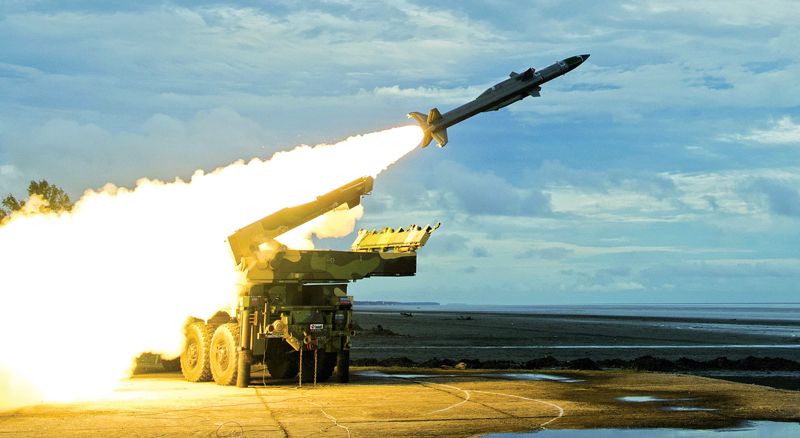India’s aerial strikes on terror infrastructure inside Pakistan under Operation Sindoor have been more than a tactical success. They are also a defining moment for India’s indigenous defence manufacturing. The first phase of the operation, running from May 7-10, saw homegrown technologies in air defence systems to precision-strike capabilities outperform foreign alternatives, proving India’s strategic autonomy in modern warfare. Scaling up the defence production and exports will further strengthen the nation’s position as a global military powerhouse.
Indigenous Air Defence Systems: The First Line of Protection
India’s multi-layered air defence network proved instrumental in thwarting enemy attacks during Operation Sindoor. The deployment of Akash surface-to-air missiles, alongside legacy air defence systems like Pechora and OSA-AK, low-level air defence (LLAD) guns created an impenetrable shield against incoming threats.
Strengthening Defence Manufacturing Through Policy Reforms

Key Contributors:
Akash Missile System: Successfully intercepted multiple aerial threats, including hostile drones and incoming ballistic missiles.
Integrated Counter-UAS Grid: The Unmanned Aerial System (UAS) effectively neutralised enemy Unmanned Aerial Vehicles (UAVs) attempting to breach Indian airspace with precision.
Electronic Counter-Counter Measures (ECCM): Ensured resilience against advanced enemy electronic warfare tactics.
The Integrated Air Command and Control System (IACCS) played a crucial role in coordinating responses across the Army, Navy, and Air Force, ensuring seamless defence operations.
Precision Strikes with Indigenous Missiles
India’s offensive strategy relied heavily on homegrown missile systems, enabling surgical precision in targeting enemy installations. The BrahMos supersonic cruise missile, developed through an Indo-Russian collaboration, was a standout performer.
Key Contributors:
BrahMos Missile: Launched from land and air, obliterating terrorist infrastructure with unmatched speed.
Pinaka Rocket Launcher: The multi-barrel rocket launcher (MRBL) delivered rapid-fire strikes, ensuring sustained firepower.
Loitering Munitions: Enabled autonomous target engagement, reducing collateral damage.
These indigenous systems outperformed foreign alternatives, reinforcing India’s strategic autonomy in modern warfare.
Strengthening Defence Manufacturing Through Policy Reforms
India’s defence manufacturing sector has witnessed unprecedented growth, driven by strategic reforms and private sector involvement. The Make in India initiative has catalysed the development of advanced military platforms.
Key Contributors:
Light Combat Aircraft (LCA) Tejas: Strengthening India’s modern aerial capabilities with agility.
Advanced Towed Artillery Gun System (ATAGS): Enhancing precision firepower in ground operations with effectiveness.
Indigenous Aircraft Carriers & Submarines: Expanding naval dominance.
Defence exports have surged to `240 billion in FY2024-25, with a target of Rs.500 billion by 2029, reinforcing India’s position as a major global arms supplier.
The Rise of Indigenous Drone Warfare
Drones have played a critical role in surveillance, reconnaissance, and precision strikes during Operation Sindoor. India’s domestically produced UAVs, such as Nagastra-1 and SkyStriker, showcased their effectiveness.
Key Contributors:
Surveillance Drones: Provided real-time intelligence, enhancing battlefield awareness.
Combat UAVs: Delivered precision strikes, neutralising high-value targets.
Counter-Drone Technology: Successfully intercepted enemy UAVs attempting coordinated retaliatory strikes.
India’s ban on imported drones and the Production-Linked Incentive (PLI) scheme have accelerated domestic innovation, positioning the country as a global drone hub.
The Future of Indigenous Defence Manufacturing
Operation Sindoor has validated India’s self-reliance in defence technology, setting the stage for next-generation innovations.
Key Priorities:
Hypersonic Missiles: Enhancing strike capabilities.
AI-Driven Autonomous Drones: Revolutionising warfare tactics.
Green Defence Technologies: Reducing carbon footprint and environmental impact.
India’s commitment to technological self-reliance ensures that future military operations will be powered by indigenous innovation, reinforcing national security and global leadership.
Source: Ministry of Defence, Open Source Intelligence, News Reports


